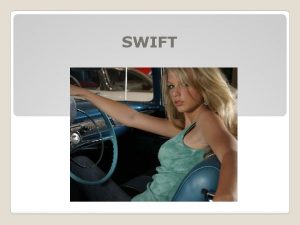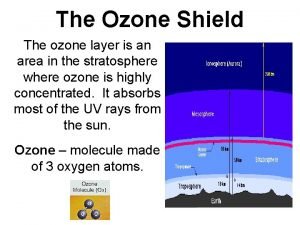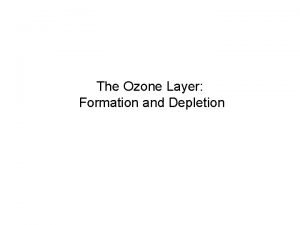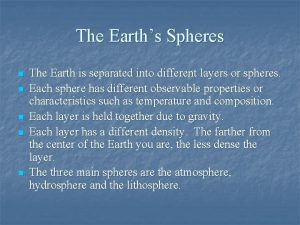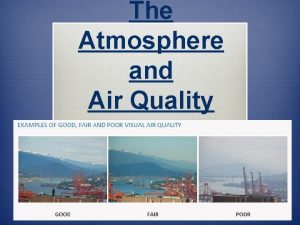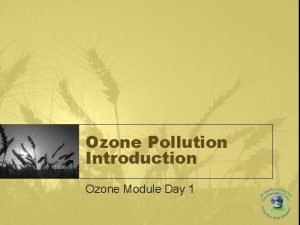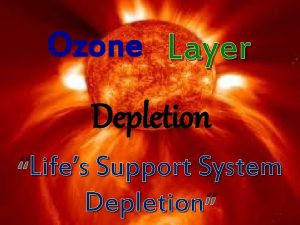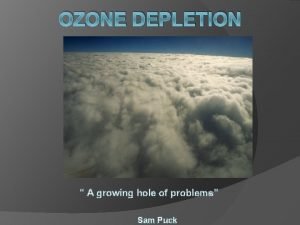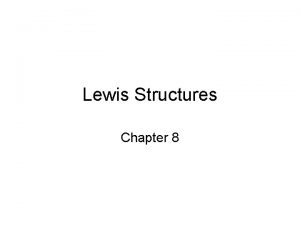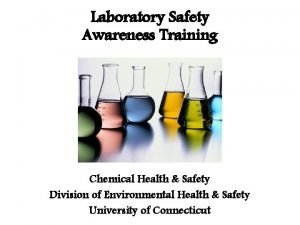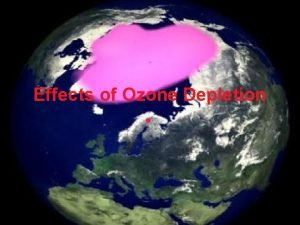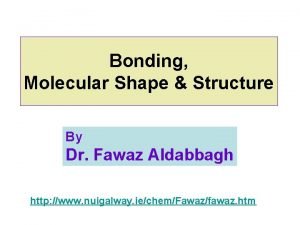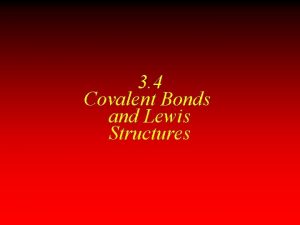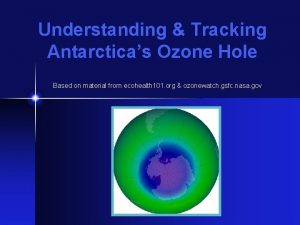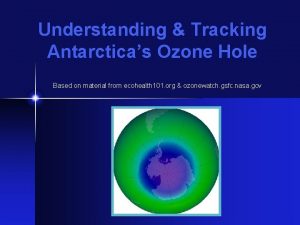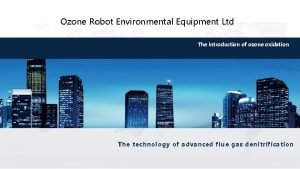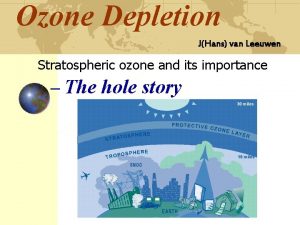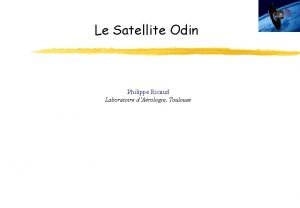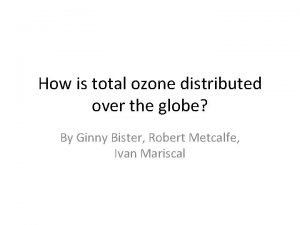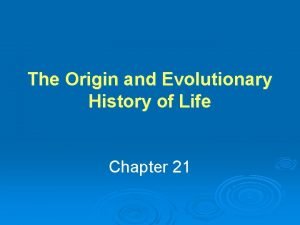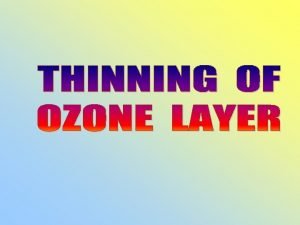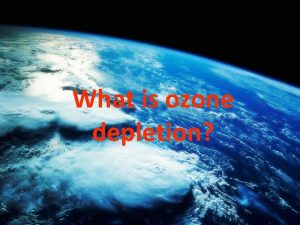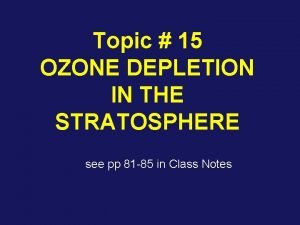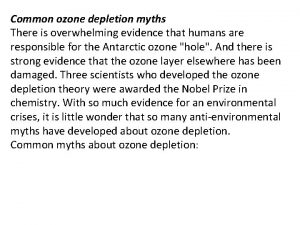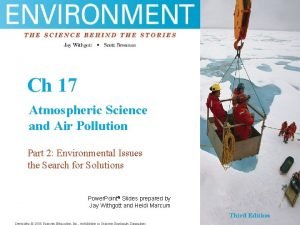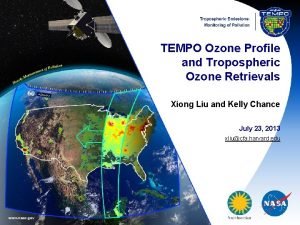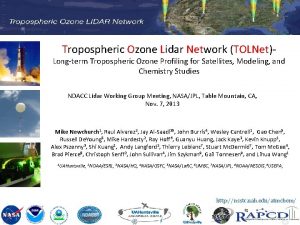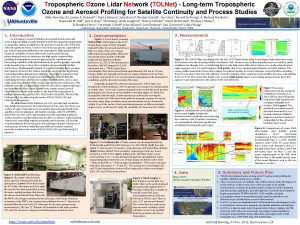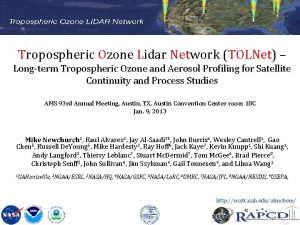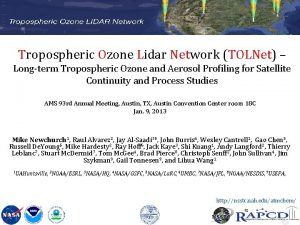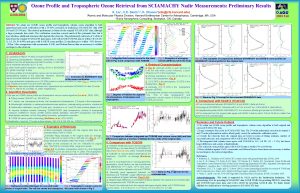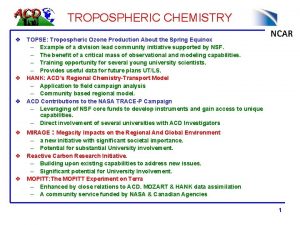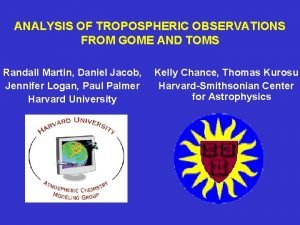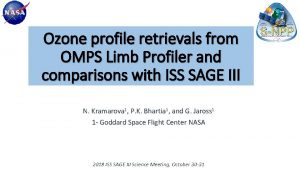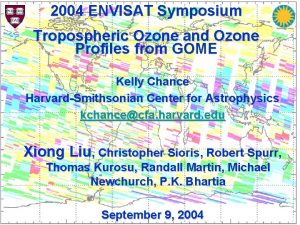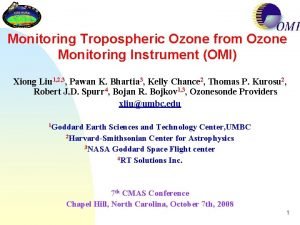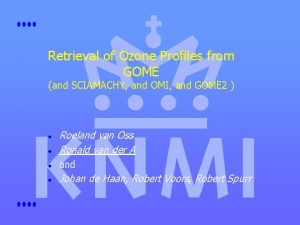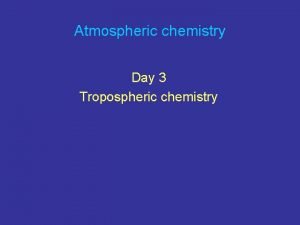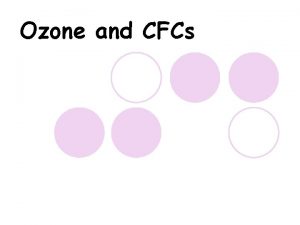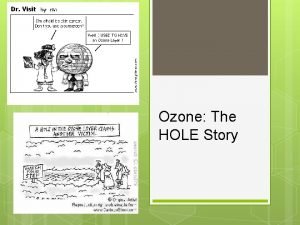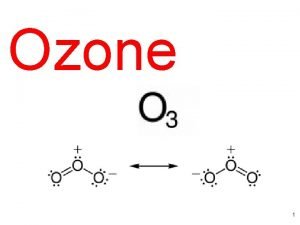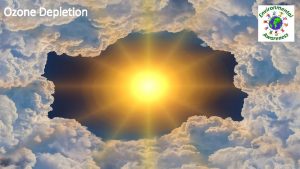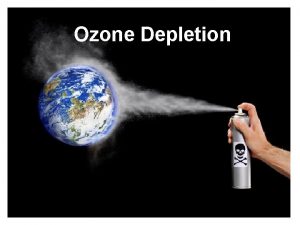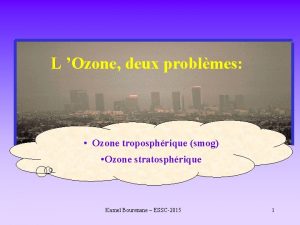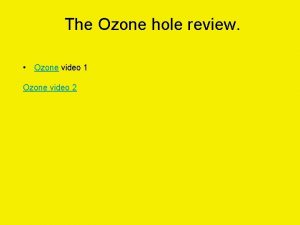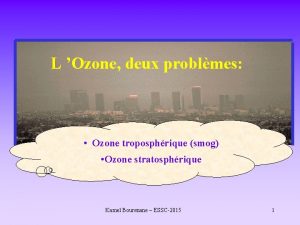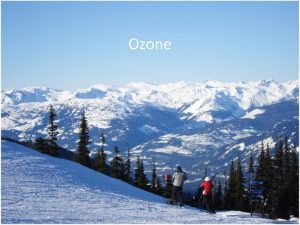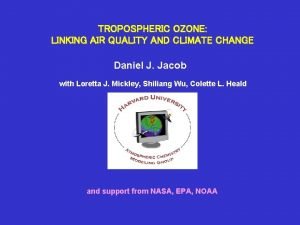Ozone Profile and Tropospheric Ozone Retrievals from GOME


![Introduction n Singer and Wentworth [1957] first proposed to derive stratospheric ozone profiles from Introduction n Singer and Wentworth [1957] first proposed to derive stratospheric ozone profiles from](https://slidetodoc.com/presentation_image_h2/8e4d4c85f00ff1020ef7fde0d804a38f/image-3.jpg)
































- Slides: 35

Ozone Profile and Tropospheric Ozone Retrievals from GOME Xiong Liu (xliu@cfa. harvard. edu) Harvard-Smithsonian Center for Astrophysics Kelly Chance, Thomas Kurosu, Christopher Sioris, Robert Spurr, Randall Martin, Mike Newchurch SSAI, Lanham, Maryland April 11, 2006 1

Outline n Introduction n Examples of Retrievals n Algorithm Description u Instrument u Forward u Inverse n Model Retrieval Characterization u Information u Error Content Analysis n Intercomparison with TOMS, Dobson/Brewer, SAGE, and Ozonesonde Measurements n Summary and Future Outlook 2
![Introduction n Singer and Wentworth 1957 first proposed to derive stratospheric ozone profiles from Introduction n Singer and Wentworth [1957] first proposed to derive stratospheric ozone profiles from](https://slidetodoc.com/presentation_image_h2/8e4d4c85f00ff1020ef7fde0d804a38f/image-3.jpg)
Introduction n Singer and Wentworth [1957] first proposed to derive stratospheric ozone profiles from backscattered UV radiation. n The idea has been successfully applied by the BUV, SBUV/2 instruments to derive a ~35 -year record of ozone profiles. n However, SBUV-like instruments provide reliable ozone profile information mainly between 1 -20 mb. Between 20 mb and surface, ozone profile could not be resolved, although column ozone amount is reliably derived (Bhartia et al. , 1996). n Can we do better especially in the troposphere? ? ? n Chance et al. (1997) performed a theoretical study to demonstrate that ozone profiles including tropospheric ozone can be derived from UV/Visible spectra (e. g. , GOME and SCIAMACHY). 3

Introduction n GOME: launched in April 1995, measures radiances in 240 -790 nm with a moderate resolution of 0. 2 -0. 4 nm and high SNR n Four physically-based ozone profile algorithms: u Munro et al. , 1998: 264 -307 nm & 326 -335 nm (2 -step, empirical corr. ) u u Hoogen et al. , 1999: 290 -355 nm (empirical Chebyshev poly. ) Hasekamp and Landgraf, 2001: 290 -313 nm van der A et al. , 2002: 260 -340 nm (empirical correction) Indicates calibration problems and the importance of calibrations n Tropospheric O 3 data have not yet been published from these algorithms. Three challenges to get good tropospheric ozone: u Consistent and accurate calibration u High fitting precision u 90% total ozone above n We recently developed our own ozone profile algorithm for GOME data and demonstrated that valuable tropospheric ozone can be derived from GOME (Liu et al. , 2005, 2006 a, 2006 b, in press, 2006 c submitted to ACP). 4

Examples of Retrievals (Ozone Profile) Ozone hole Biomass burning over Indonesia 5

Examples of Tropospheric Column Ozone (TCO) Zonal contrast in the tropics Biomass burning over Indonesia 6

GOME Tropospheric Column Ozone (19961999) 7

Algorithm Description n Measurements: 289 -307 nm, 325 -340 nm, 368 -372 nm, coadd 8 channel 2 pixels to channel 1 resolutions (960 x 80 km 2) n Results: u Partial Column O 3 at 11 layers (each ~5 km thick except for the top layer) u Now at 24 layers (each ~2. 5 -km thick) u NCEP tropopause to separate stratosphere & troposphere (2 -3/4 -6 layers) n Spectral fitting + Optimal Estimation + LIDORT n Three Keys: u Accurate calibration of the measurements u Accurate forward modeling (LIDORT with additional corrections) u Good knowledge of climatological a priori information (mean and standard deviation) and measurement errors Liu et al. , 2005, JGR 8

High Resolution Solar Reference Spectrum 9

Instrument Model n Use GDP extraction software with all standard corrections n Instrument slit function characterization (Chance, 1998) u Assume Gaussian, use non-linear least squares fitting u High resolution solar reference spectrum (Caspar and Chance, 1998) u Variable slit widths (21 spectral pixels in 5 -pixel increments) 10

Instrument Model n Wavelength calibration (Caspar and Chance, 1997) u Similarly determined except with variable slit widths (15 spectral pixels in 3 -pixel increments) u Include wavelength shifts among radiances, irradiances and trace gas cross sections in the spectral fitting. 11

Instrument Model n Undersampling correction (Chance, 1998) u GOME significantly undersamples the spectrum u Use the high-resolution solar spectrum to simulate the sampling process and determine two basis functions for undersampling correction u Include a scaling factor for each basis function in the fitting n Radiometric Calibration and Degradation Correction u Wavelength-dependent bias in Channel 1 (van der A et al, 2002) u Degradation in reflectance since 1998 due to the build-up of a thin ice layer on scan mirror (Tanzi et al. , 2001) u Include a wavelength-dependent correction (2 nd-order polynomial) in the fitting in 289 -307 nm, constrained by the total ozone derived from the Huggins bands and the a priori profiles. u Degradation since 2000 largely affects the retrieved tropospheric ozone u External degradation correction is necessary. u Degradation correction derived using ozone profile climatology or observations [van der A et al. , 2002; Landgraf et al. , 2005] shows significant variation with latitude and station. 12

Instrument Model n We derive an simpler scheme by comparing global-averaged reflectance over 60ºN 60ºS to that in the first six months with additional steps to remove SZA and seasonal dependent components. n Degradation largely depends on scan-angle and wavelength. Liu et al. , 2006, submitted to ACP 13

Forward Model n LIDORT with pseudo-spherical approximation and 6 streams n Polarization correction with a look-up table: wavelength, total ozone, surface albedo and pressure, viewing geometry (courtesy of Roeland F. van Oss) n Ring effect: directly model the 1 st-oder RRS of the direct beam u Account for dependence on ozone profile and SZA (Sioris & Evans, 2002) u Use actual GOME solar irradiance u Ring spectra are updated when the total ozone change is > 20 DU u Scaling parameters are fitted in retrieval. n Clouds/Surface: Lambertian surface, Independent pixel approx. u Cloud-top pressure from GOMECAT (Kurosu et al. , 1999) u Initial surface albedo from an albedo database (Koelemeijer et al. , 2003) u Cloud fraction is derived from 370 nm and fixed by assuming a cloud albedo of 80% unless it is overcast, when we derive cloud albedo. u Surface albedo is varied in the retrievals u A wavelength-dependent albedo (2 nd polynomial) is used for channel 2 14

Forward Model n Aerosols n Monthly mean SAGE-II stratospheric aerosols (extinction & effective radius) (Bauman et al. , 2003) n Monthly mean GOCART tropospheric aerosols (dust, sulfate, black & organic carbon, coarse and fine sea salt) (Chin et al. , 2002) as described in Martin et al. (2003), optical properties (using Mie ) are externally mixed. n Wavelength-dependent surface albedo accounts for residual aerosol effects. http: //hyperion. gsfc. nasa. gov/People/Chin/aot. html 15

Forward Model n Trace Gases: u Only O 3 is modeled in LIDORT with ozone cross sections by Daumont et al. (1992), Brion et al. (1993), Malicet et al. (1995) u Previous version: fit cross sections of NO 2, SO 2, Br. O u Now fit weighting functions of NO 2, SO 2, Br. O, and HCHO weighted by profile shapes from models due to large AMF variation with wavelength v NO 2: PRATMO + GEOS-CHEM v Br. O: PRATMO + well mixed in the troposphere v SO 2/HCHO: GEOS-CHEM model simulations, no stratospheric n NCEP surface & tropopause pressure, ECMWF temperature n Effective viewing geometry (integrate and average geometric path lengths from west to east edge) n Weighting functions other than ozone, albedo, and shift parameters are derived with the finite difference approach. 16

Inverse Model n Measurement vector: n State vector: ozone variables + auxiliary parameters (albedo, shifts, trace gas, Ring effect, undersampling, degradation etc. ) n Measurement error: GOME random-noise error (RSS of I + F, uncorrelated) n A priori information: n 3 -D (month, latitude, altitude) ozone climatology by Mc. Peters et al. [2003]: mean and standard deviations at 61 levels (0 -60 km) (from 15 years of SAGE, ozonesonde and MLS) n Use a correlation length of 6 km to construct a priori covariance matrix n Other parameters: assumed empirically or based on retrieval statistics and are uncorrelated with the rest 17

Inverse Model n Convergence criteria: ozone/cost function change <1% n Convergence: 3 -5 iterations, usually 2 -3 iterations if initialized with a previous retrieval n One orbit: 36 mins on a 3. 2 -GHz processor (LIDORT, variable slit/wavelength calibrations), process 1 -day GOME data in 8. 7 hrs and process GOME-2 data daily with 3 such CPUs n Fitting residuals: 18

Informational Analysis --- Averaging Kernels 8 -12 km (at 20 -38 km) VR: 7 -12 km (at 10 -37 km) 19 7 -12 km (at 7 -37 km)

Informational Analysis --- DFS and A Priori Influence DFS: 1. 2 DFS in the tropics, 0. 5 at high latitudes 20 A Priori influence in TCO: 15% in the tropics, 50% at high-latitudes

Error Analysis Precision: 2 -8% (< 2 DU) in the strat. , <12%(5 DU) in the troposphere Smoothing: <10% at 20 -40 km, 15% at > 40 km, and 30% at <10 km TO: <2 DU(0. 5%); SCO: <2 DU(1%); 3 DU (1. 0%) 2 -5 DU (1 -2%) TCO: 1. 5 -3 DU(6 -10%); 3 -6 DU(12 -20%) 21

Liu et al. , 2005, JGR Error Analysis 22

Total Column Ozone Comparison n Comparisons with total ozone /ozonesonde at 33 sonde stations n TOMS: avg. points within GOME, mean biases are <6 DU (2%) at most stations with 1 <1. 5% in tropics and <2. 4% at high latitudes n Dobson: ± 8 hrs, ± 1. 5ºlat, ± 500 km lon, mean biases are mostly <5 DU (2%) with 1 < 3% in the tropics and <5% at high latitudes Liu et al. , 2005, 2006 a, 2006 b (in press) 23

Intercomparison with SAGE-II n Comparisons with SAGE-II in 1996 -1999 down to ~15 km: same day, ± 1. 5ºlat, ± 5ºlon n Apply GOME averaging kernels n Systematic biases: usually <15% with 1 <10% at ~20 -60 km and <15% at ~15 -20 km n Column ozone: negative biases of 3 -6 DU at 35 -60 km, <2. 5 DU at ~15 -35 km Liu et al. , 2005, JGR; Liu et al. , 2006, in press 24

Comparison with Ozonesonde. Tropospheric Column Ozone 25

Comparison with Ozonesonde Tropospheric Column Ozone 26

Comparison with Ozonesonde Tropospheric Column Ozone n GOME tropospheric column ozone captures most of the temporal variability in ozonesonde TCO. 27

Comparison with Ozonesonde Tropospheric Column Ozone n Mean biases: <3. 3 DU (15%) at 30 stations; 1 : 3 -8 DU (12 -27%) n Improvements over a priori at most stations: either reduces MBs or 1 or 28 increases the correlation

Comparison with Ozonesonde and SAGE-II SCO n Stratospheric column ozone between layer 4 and 7 (15~35 km) or between tropopause and layer 7 n GOME/SONDE SCO (15 -35 km): usually higher by 8 -20 DU (5 -8%) at CI & most tropical stations n GOME/SAGE-II SCO (~15 -35 km): usually within ± 2. 5 DU (1. 5%) except for 3 Northern European stations 29

Comparison with Ozonesonde SCO n GOME SCO compares better with 1%-KI buffered than 2%-KI unbuffered by 11 -16 DU. n Altitude-dependent total ozone normalization reduces the bias contrast and GOME/sonde biases mainly with 2%-KI 30 unbuffered. http: //www. cmdl. noaa. gov/infodata/ftpdata. html

Profile Comparison with Ozonesonde n Systematic biases n Large positive biases of (30 -70%) at Carbon Iodine and most tropical stations 31

Profile Comparison with Ozonesonde n The biases relative to 1%-buffered is usually smaller by 5 -15%. n Altitude-dependent homogenization reduces the bias with 2%-unbuffered. n Uncorrected altitude hysteresis can account for 5 -15% biases. 32

Profile Comparison with Ozonesonde and SAGE-II n GOME/SAGE-II: usually <5% at layer 5 and 8 -20% for layer 4 n GOME/Sonde: mostly 5 -20% for layer 5 and 20 -60% for layer 4 33

Summary and Future Outlook n Ozone profiles and tropospheric column ozone are retrieved from GOME spectra (289 -307 nm, 325 -340 nm) using the optimal estimation after extensive treatments of wavelength and radiometric calibrations and forward modeling. n Retrieved TO compares well with TOMS and Dobson/Brewer measurements to within 2% at most locations. n The mean biases and 1 with SAGE are usually within 15% down to ~15 km. n The retrieved TCO captures most of the temporal variability in ozonesonde TCO; the mean biases are usually within 15% and 1 are within 13 -27%. n The large biases between GOME and ozonesonde in the stratosphere and upper troposphere at carbon iodine stations and most stations in the tropics, reflect biases in ozone retrievals as well as ozonesonde measurements. n The biases depend on sonde technique, sensor solution and data processing, therefore demonstrating the need to homogenize available ozonesonde datasets and standardize future operational procedures for reliable satellite validation. n Derive ozone profiles from GOME data during July 1995 to May 2003. n Continue to improve and speed up the retrievals and apply this algorithm to SCIMACHY, GOME-2, and OMI data. 34

Acknowledgements n n n Supported by NASA and the Smithsonian Institution ESA and DLR TOMS, SAGE, WOUDC, SHADOZ, CMDL NCEP, ECMWF, GEOS-CHEM, GOCART, PRATMO G. Labow for providing ozone profile climatology. 35
 Swift finance retrievals
Swift finance retrievals Gome dept
Gome dept Gome dept
Gome dept Nyttofunktion
Nyttofunktion Gome dept
Gome dept Effect of ozone depletion on plants
Effect of ozone depletion on plants How do cfcs destroy ozone
How do cfcs destroy ozone Protective ozone layer
Protective ozone layer Ozone composition
Ozone composition Photonic medicine
Photonic medicine Atmega44
Atmega44 Protective ozone layer
Protective ozone layer Ozone layer depletion
Ozone layer depletion Ozone layer facts
Ozone layer facts The ozone blanket blocks
The ozone blanket blocks Pcl lewis dot structure
Pcl lewis dot structure Ozone hazard symbol
Ozone hazard symbol Ozone depletion effects on humans
Ozone depletion effects on humans O3 molecular geometry
O3 molecular geometry Ncnh lewis structure
Ncnh lewis structure Causes of the ozone depletion
Causes of the ozone depletion Ozone layer depletion introduction
Ozone layer depletion introduction Poisonous
Poisonous Stratospheric ozone depletion
Stratospheric ozone depletion Trou d'ozone
Trou d'ozone How is total ozone distributed over the globe
How is total ozone distributed over the globe How ozone forms
How ozone forms Ozone layer made up of
Ozone layer made up of Protection of ozone layer
Protection of ozone layer Size multiplier vray sun
Size multiplier vray sun Ozone depletion diagram
Ozone depletion diagram Cause of ozone depletion
Cause of ozone depletion Ozone without borders
Ozone without borders Ozone hole myth
Ozone hole myth Ozone layer levels
Ozone layer levels Copyright
Copyright
